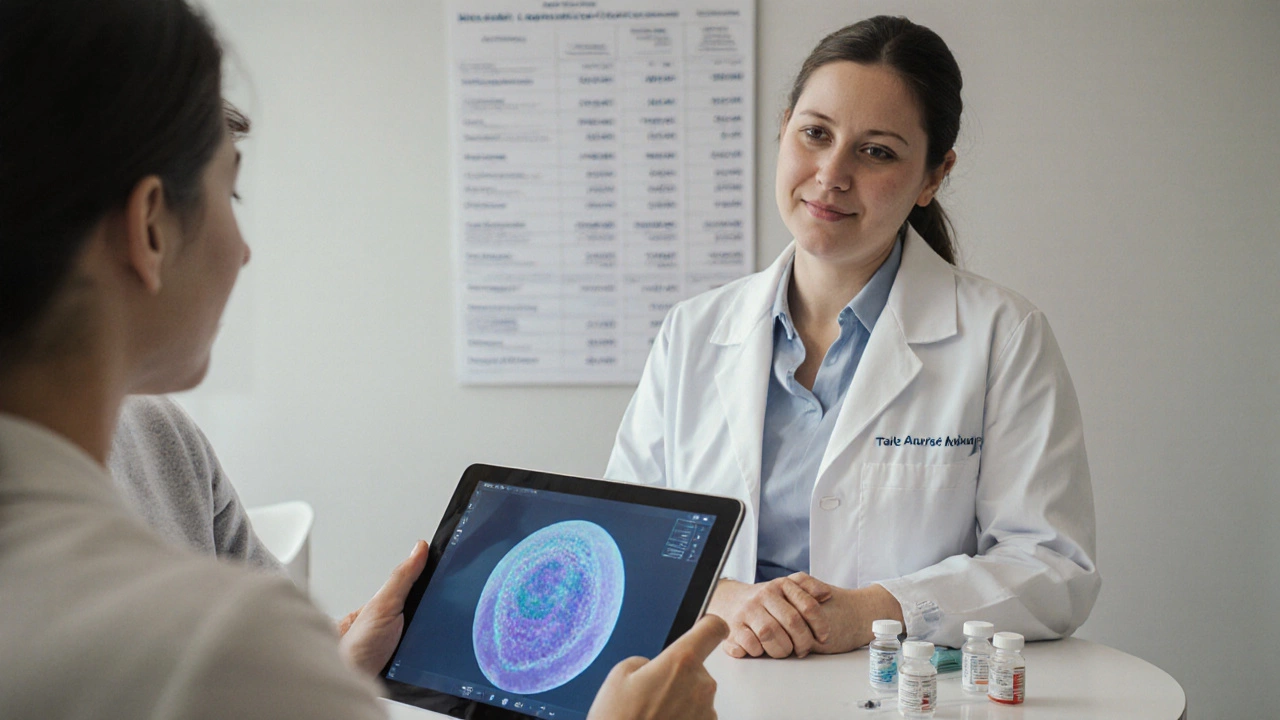
IVF Cost Estimator 2025
Estimated IVF Cost Summary
Breakdown:
Important Notes
These estimates are based on 2025 national averages and regional variations. Actual costs may vary depending on clinic policies, individual medical needs, and additional procedures.
Thinking about starting a family and wondering how much IVF cost in the US really looks like? You’re not alone. Couples across the country face a maze of prices, insurance quirks, and hidden fees before they can hold that first baby bump. This guide breaks down every dollar you’re likely to see, shows where costs shift from coast to coast, and gives you practical steps to keep the bill from blowing your budget.
Quick Takeaways
- Average national IVF cycle in 2025: $13,000-$16,000 (medications add $3,000-$5,000).
- States with mandatory insurance coverage (e.g., MA, RI, NJ) can lower out‑of‑pocket costs by 30‑50%.
- Adding preimplantation genetic testing (PGT) adds $2,500-$4,000 per cycle.
- Embryo freezing and storage average $1,200-$2,500 upfront, then $300‑$500 per year.
- Financing programs, fertility grants, and medication coupons can shave $5,000‑$10,000 off the total.
What Is IVF?
In vitro fertilization (IVF) is a assisted reproductive technology where eggs are retrieved, fertilized with sperm in a lab, and the resulting embryos are transferred back into the uterus. It’s the most common ART (assisted reproductive technology) in the United States, accounting for roughly 85% of all cycles performed each year.
Average National Cost Breakdown
When you ask a clinic for a quote, you’ll typically see three major line items:
- Clinic and laboratory fees - covering monitoring, egg retrieval, fertilization, embryo culture, and transfer.
- Fertility medication - hormone injections that stimulate egg production.
- Optional add‑ons - such as PGT, embryo cryopreservation, and assisted hatching.
Based on data from the Society for Assisted Reproductive Technology (SART) and a 2025 pricing survey of 200 U.S. clinics, the average costs look like this:
| Component | Average Cost (USD) |
|---|---|
| Clinic & Lab Fees | $9,500-$12,000 |
| Medications | $3,000-$5,000 |
| PGT (optional) | $2,500-$4,000 |
| Embryo Freezing & Storage (first year) | $1,200-$2,500 |
So a typical first cycle without add‑ons lands around $12,500, while a more comprehensive approach (meds + PGT + freezing) can push the total above $20,000.
What Drives Those Numbers?
Understanding each cost driver helps you spot where you might save.
- Clinic reputation and location. High‑volume academic centers often charge less per cycle than boutique private practices.
- Medication protocols. Different drugs (e.g., gonadotropins, GnRH antagonists) have varied price tags. Some clinics offer “low‑dose” protocols to reduce medication spend.
- Laboratory technology. Clinics using advanced time‑lapse imaging or next‑generation sequencing for PGT typically add a premium.
- Success rates. Higher success percentages can justify higher fees, but they also mean you may need fewer cycles overall.

Regional Cost Variations Across the United States
Geography matters. Below is a snapshot of average IVF cycle costs by region, based on the 2025 SART data set. All figures include clinic and lab fees plus a standard medication package.
| Region | Average Cost (USD) | Notes |
|---|---|---|
| East Coast (e.g., MA, NY, DC) | $15,000-$18,000 | Higher due to cost‑of‑living and mandatory insurance in some states. |
| Midwest (e.g., IL, OH, MO) | $12,000-$14,500 | Generally lower clinic fees, but medication costs comparable. |
| South (e.g., TX, FL, GA) | $11,000-$13,500 | Many clinics offer discount packages for multiple cycles. |
| West Coast (e.g., CA, WA, CO) | $14,500-$17,500 | High demand and tech‑focused labs raise prices. |
Insurance Landscape: What’s Covered?
Insurance is the wild card that can chop off a large chunk of the bill. In the United States, coverage varies dramatically from state to state.
Health insurance plans that include fertility benefits typically cover:
- Diagnostic testing (e.g., hormone panels, ultrasound).
- Some or all medication costs.
- Up to a set number of IVF cycles (often 1‑2).
However, many large employers still label IVF as an “elective” procedure, meaning you’re on the hook for the full amount. States with mandatory insurance coverage for infertility treatment include Massachusetts, Rhode Island, New Jersey, Connecticut, and Illinois. In those states, out‑of‑pocket costs can drop to $5,000‑$7,000 per cycle.
If your state doesn’t require coverage, you can still explore:
- Employer‑specific fertility riders.
- Health Savings Accounts (HSAs) or Flexible Spending Accounts (FSAs) to use pre‑tax dollars.
- State‑run programs like California’s “Medi-Cal Fertility” for qualifying low‑income families.
Financing Options and Ways to Reduce the Bill
Even with insurance, many couples need extra cash flow. Here are the most effective strategies:
- Clinic financing plans. Some clinics partner with lenders offering 0‑5% APR loans with repayment terms of 12‑36 months.
- Fertility grants. Organizations such as the Baby Quest Foundation or the RESOLVE: The National Infertility Association provide one‑time grants ranging from $2,500 to $10,000.
- Medication discount programs. Brands like Gonal‑F and Menopur have patient assistance coupons that can shave $1,000‑$2,000 off each prescription.
- Package deals. Many clinics bundle multiple cycles, PGT, and freezing for a flat fee that’s 10‑20% lower than paying per cycle.
- Tax‑advantaged accounts. Contribute the maximum $3,850 (individual) or $7,750 (family) to an HSA each year to offset future IVF expenses.
Hidden Costs You Might Overlook
Beyond the headline numbers, keep an eye on these sneaky expenses:
- Blood work and monitoring. Some clinics charge per‑visit labs that can add $200‑$500 each.
- Anesthesia fees. General anesthesia for egg retrieval can cost $1,000‑$2,000, while conscious sedation is cheaper.
- Embryology lab storage after the first year. Annual fees hover around $300‑$500 per embryo.
- Legal paperwork for embryos. If you plan to use a donor or third‑party gestational carrier, legal contracts can run $2,000‑$5,000.

How to Get an Accurate Quote - Step‑by‑Step
- Identify three clinics within a 100‑mile radius. Look for SART‑accredited centers.
- Request a detailed cost breakdown that lists each component separately (clinic, meds, lab, anesthesia, add‑ons).
- Ask about success rates for patients in your age bracket; higher success may mean fewer cycles.
- Verify your insurance benefits: ask both your insurer and the clinic’s billing department for a pre‑authorization estimate.
- Calculate total out‑of‑pocket cost by adding medication coupons, grant amounts, and any financing interest.
- Compare the total “all‑in” numbers, not just the headline price.
Cost Comparison Table
| Option | Clinic & Lab | Medications | PGT | Freezing & Storage (Year1) | Total Approx. |
|---|---|---|---|---|---|
| Basic IVF (no add‑ons) | $10,000 | $3,500 | $0 | $0 | $13,500 |
| IVF + PGT | $10,000 | $3,500 | $3,000 | $0 | $16,500 |
| IVF + Freezing | $10,000 | $3,500 | $0 | $2,000 | $15,500 |
| Full Package (PGT + Freezing) | $10,000 | $3,500 | $3,000 | $2,000 | $18,500 |
Key Takeaways for Prospective Parents
- Start with a transparent, itemized quote - no surprises later.
- Check if your state mandates coverage; that can cut the bill dramatically.
- Leverage medication coupons, grant programs, and bundled cycle discounts.
- Budget for hidden fees like anesthesia, annual embryo storage, and legal paperwork.
- Plan financing early; low‑interest loans or HSA contributions can smooth cash flow.
Frequently Asked Questions
What is the average out‑of‑pocket cost for a single IVF cycle in 2025?
For most couples without insurance coverage, the total out‑of‑pocket expense ranges from $13,500 to $16,000, covering clinic fees, medications, and basic laboratory work.
Does insurance ever cover IVF in the United States?
Yes, but only in states with mandated infertility coverage (e.g., Massachusetts, Rhode Island, New Jersey, Connecticut, Illinois) or when you have an employer‑offered fertility rider. Even then, most plans limit the number of covered cycles and may require a deductible.
How much does preimplantation genetic testing add to the price?
PGT typically adds $2,500-$4,000 per cycle. It can improve success rates and reduce the chance of miscarriage, which many couples find worth the extra cost.
Are there financing options if I can’t pay cash?
Many clinics partner with lenders offering 0‑5% APR loans, and there are fertility‑specific grants from charities like Baby Quest. Using an HSA or FSA can also reduce taxable income, stretching your budget further.
What hidden fees should I anticipate?
Watch for per‑visit blood work ($200‑$500), anesthesia for egg retrieval ($1,000‑$2,000), annual embryo storage ($300‑$500 per year), and legal contracts if using a donor or gestational carrier ($2,000‑$5,000).
Next Steps
Ready to turn curiosity into action? Start by gathering quotes from three accredited clinics, ask your insurer about fertility benefits, and explore at least one grant or medication discount program. The more information you collect now, the smoother the financial journey will be when you’re ready to begin treatment.






